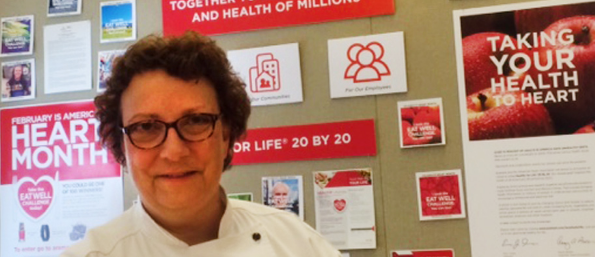Annette Gray, Leader Culinary Innovation and Research and Development Chef for Aramark.

For years, we at Aramark have been working on our commitment to health and wellness, with our team of 750 dietitians and our Healthy for Life® program in place. At the same time, the American Heart Association had been working on improving the cardiovascular health of all Americans and reducing deaths from cardiovascular diseases and stroke by 20 percent. In 2015, when we realized we shared common goals, we decided to team up and Healthy for Life 20 by 20 was born, our joint initiative to, by 2020, improve the health of all Americans by 20 percent.
How exactly do we plan to achieve this ambitious goal over five years? In addition to consumer education, community health programs and other efforts, a significant portion of our initiative involves healthy menu innovation to reduce calories, saturated fat and sodium levels while increasing fruits, vegetables and whole grains. Because we’re one of the largest food service providers in the U.S., these changes we’re making in our kitchen stand to impact 10 billion meals by 2020.
- Sandwich bread swaps: To start, we completely overhauled our sandwich program to include more whole grain options. Most people don’t realize that sliced bread is a sneaky source of salt and some whole grain brands are actually higher in sodium than white breads. Our Product Development team asked consumers while our chefs conducted robust recipe testing to find the best options that would not compromise taste or increase overall sodium levels. This enabled us to keep quality paramount and our consumers satisfied. So when you’re shopping for bread, even whole grain types, check the nutrition labels for sodium content.
- Healthy condiments hacks: We’re challenging the norm when it comes to everyday condiments, too. In some of our accounts, we’re switching from mayonnaise to Greek yogurt. This helps cut down on sodium, saturated fat, and calories, and it gives a little protein boost without impacting overall flavor. Another healthy condiment we’re incorporating is hummus. Most people probably think of this as a dip but this chickpea-based spread has a thick and creamy texture that has been well received on some of our vegetarian sandwich options and in some of our salad dressing recipes.
- Staying in season: We’ve made great strides in keeping our produce seasonal as a way to keep our customers excited and we’re happy to say it’s worked. Fresh fruit and vegetables typically have more flavor when they’re in season. Think of sweet corn and strawberries in the summer and delicious, juicy oranges in the winter. Filling up on fruits and vegetables naturally helps displace more processed foods which are typically higher in sodium.
- Plant-forward bowls: One of our greatest successes has been featuring whole grain bowls. Our bowl meals incorporate 50 percent whole grains, like farro, quinoa or brown rice and 50 percent vegetables, like Brussel sprouts, bell peppers, winter squash, mushrooms and more. Our grain bowls only have an average of 430 milligrams of sodium.
- Small steps: One of the biggest lessons we’ve learned in enhancing with our menus is that you can’t go from zero to 100. For example, instead of completely removing sodium from our soups right away, or moving all the way to low sodium varieties that many people don’t enjoy, we make subtle changes by reducing the amount of sodium by 100 or 200 milligrams at a time – replacing sodium as we go with other flavorful ingredients like herbs and spices and even vegetables purees.https://sodiumbreakup.heart.org/healthy_menu_innovation_that_can_help_everyone_be_healthy_for_life?utm_source=SRI&utm_medium=Email&utm_term=HFGweekly&utm_content=Aramark&utm_campaign=SodiumBreakup
